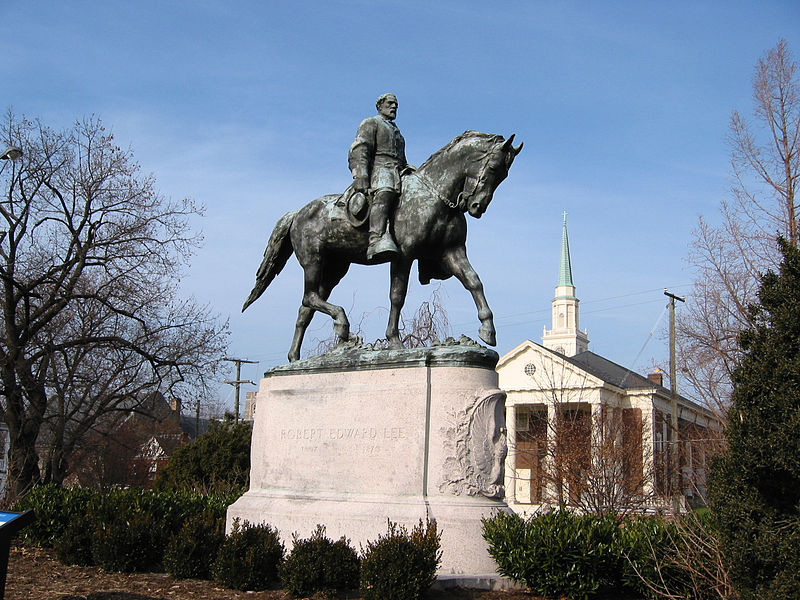Removing Confederate monuments is a critical step towards national reunification
Courtesy of Wikipedia via Creative Commons
Confederate monuments serve no purpose considering the time period in which they were built. The context behind their construction indicates that they represent something darker than a mere memory of the Civil War.
September 21, 2017
“The beauty that is being taken out of our cities, towns and parks will be greatly missed and never able to be comparably replaced!” President Donald Trump tweeted on August 17 in response to the removal of Confederate monuments in cities across America, specifically Charlottesville, Virginia.
This statement left most Americans with their jaws dropped and others with their heads cocked and eyebrows scrunched. And, of course, it left some Americans nodding their heads in agreement.
However, regardless of the President’s impulsive twitter posts, these statues have festered a heated debate within the nation: To what extent should we enshroud our controversial history?
Confederate monuments haven’t always been around. In fact, the majority of them were erected long after the Civil War.
Even so, Robert E. Lee (a former Confederate general whose statue was in Charlottesville, VA before being removed) was not in favor of receiving a monument at all. According to Jonathan Horn, a Lee biographer, the former general was actually very supportive of erasing the evidence of the Civil War altogether.
In an article by Daniel Brown at Aol News, Horn says, “‘Lee believed countries that erased visible signs of civil war recovered from conflicts quicker…[and] [h]e was worried that by keeping these symbols alive, it would keep the divisions alive.’”
For the record, Lee wasn’t buried in his Confederate uniform, nor did he want the Confederate flag to be flown after the war, much less at his own funeral service. Those who think that removing these statues is “destroying history” or “dishonoring Lee” are terribly mistaken. Lee would’ve said so himself.
Some have also weakly argued that we need the monuments to remember the South’s history.
The point has been rebutted by several different outlets, including responses to Trump’s earlier tweet, that monuments don’t make us remember history any more than a history book does.
One, the everyday passerby of these statues will only notice them and recognize their message if they understand the context. If they don’t know the story behind the person that is the statue, then it holds no significance to them.
Take this scenario for example: Imagine a statue of Ku Klux Klan members with a simple placard that reads, “In memory of the brave members of the Ku Klux Klan.” If you know who the Ku Klux Klan is, then you’re appalled at the presence of the statue; it serves no other purpose to you.
But if you aren’t familiar with the white supremacist group, then the statue is merely a piece of abstract art. The heinous crimes committed by these white men in hoods are meaningless to you, regardless of the monument.
Additionally, Twitter user Jordan Shapera directly responded to Trump’s earlier tweet with a very clearly expressed message:
“Surprisingly, while it is illegal to hang swastika’s [sic] and put up statues of Hitler in Germany, people still f***ing remember the Holocaust!”
There are two sides to every story. This is widely recognized as a fact.
But in the case of the Civil War, most Americans have come to the agreement that one side was definitely in the wrong, and the other was fighting for a noble cause. It is one of the most tender wars to remember because it was, sometimes literally, a battle between American brothers. North vs. South, Americans vs. Americans.
There wasn’t a common enemy to be fought, but instead combat against one another. Similarly to the presidential election of 2016, this war tore the nation apart. As stated by former president Abraham Lincoln, “A house divided against itself cannot stand.”
And now we face the hardest obstacle of all—reuniting a nation that is still divided, even after 200 years.
The answer, according to James Grossman, the executive director of the American Historical Association, is definitely not statues of dead soldiers who fought to keep African Americans in bondage.
“‘These statues were meant to create legitimate garb for white supremacy,’” Grossman says in a recent article by Miles Parks, a journalist for NPR. “‘Why would you put a statue of Robert E. Lee or Stonewall Jackson in 1948 in Baltimore?’”
Confederate memorial monuments were not erected to honor those who fought a valiant fight, as they are commonly misconceived to be. In fact, the time periods during which most of the statues were established reveals a drastically different message.
“A look at this chart shows huge spikes in construction twice during the 20th century: in the early 1900s, and then again in the 1950s and 60s. Both were times of extreme civil rights tension,” Parks says.
These menacing statues were intentionally established to promote white supremacy.
As a nation, we have come too far since Jim Crow and other racially derogatory times to tear open these wounds again, which is why removal of Confederate monuments are a crucial part of the healing process. Today’s diverse America has no need nor desire for these statues, and keeping them on their pedestals is simply a reminder of a shameful part of our history.
In regard to reuniting the nation, I’m not sure where it ends, nor where it begins, but I definitely know that removing racist monuments is a vital step. If an oversized, copper statue of a man on a horse is compromising our safety, ability to work together, and overall well-being, then by all means, take it down.








